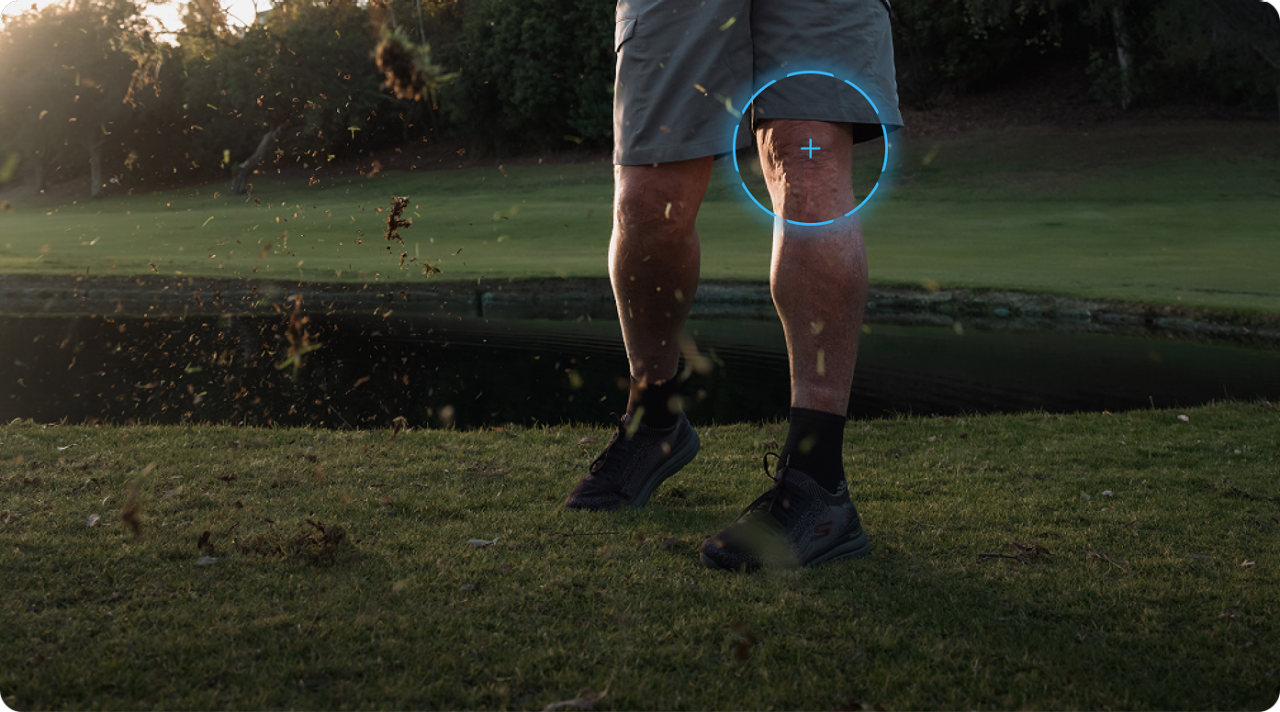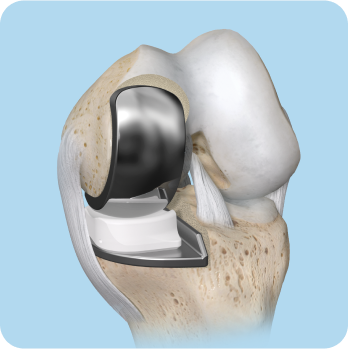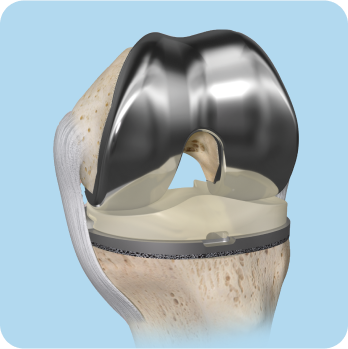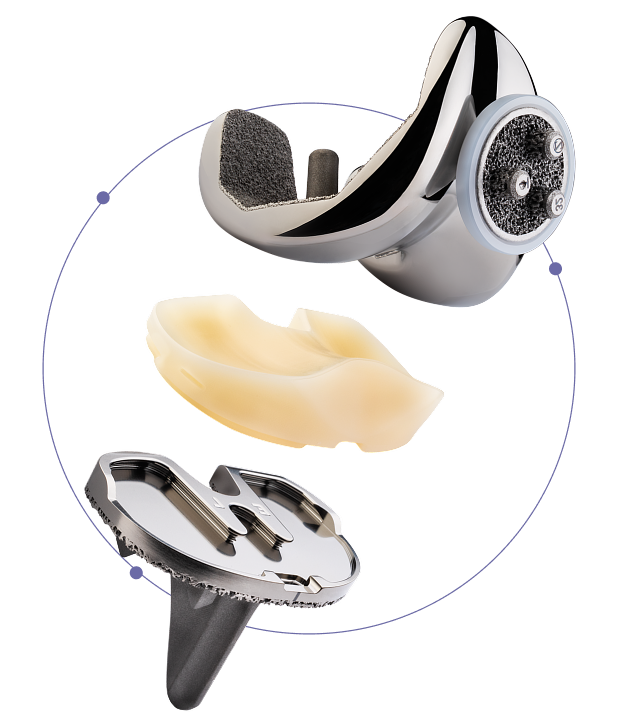TREATMENT OPTIONS
So, what's the knee pain game plan?
There are lots of ways to
kick pain to the curb
From non-pharmaceutical treatments to surgical replacement options, we’ve got plenty of ways to help you tackle knee pain.

A real Personalized Knee® experience
You’ve gotta start somewhere
These basic self-care strategies are good starting points for managing symptoms. If these don’t work well enough, you may want to talk to your doctor about medications for relief.
Cold/heat, supports, pain creams
Treat with cold or heat; use supports like canes, knee braces, or shock-absorbing shoe inserts; or apply topical pain creams with ingredients like capsaicin, menthol, camphor, or CBD.
Exercise, physical therapy, integrative medicine
Stay active with swimming, biking, or walking; use physical therapy to help increase strength and flexibility; consider acupuncture or massage.
Weight loss
Carrying extra weight puts more stress on your knees. And fat cells around your joints? They can stir up inflammation your joints could do without.
What we usually mean by “first-line”
Conservative treatments like these have been used for decades. And we have a sneaking suspicion you’ve tried some of them. Again, it’s important to talk to your doctor about what might be safest and best for you.
- Acetaminophen (e.g., Tylenol®) and non-steroidal anti-inflammatory drugs (NSAIDs) (e.g., Advil®, Aleve®)
- Medicated gels or creams that include NSAIDs (e.g., Voltaren®), lidocaine (e.g., Aspercreme®) or salicylates (e.g., BenGay®)
- Prescription drugs are sometimes used to treat chronic pain
If the medicines above prove to be ineffective, you and your doctor may choose knee injections or decide that surgery is required.
All trademarks are the property of their respective owners.
Knee Injections: Now we’re getting serious
If you decide on this treatment
option, a healthcare professional
will inject treatments directly into
the areas affected by arthritis,
inflammation, or joint pain.
Although there are many different brands and types of injections for knee pain, the two main categories are:
Corticosteroid Injections
(glucocorticoids, or simply “cortisone/steroid”)—a combination of a steroid, like cortisone, and a numbing agent. Fun fact—well, not so fun if it’s your knee: according to the Arthritis Foundation, repeated cortisone shots can actually wear down cartilage and mess with the tendons and ligaments around your joint.
Lubrication and gel injections
(hyaluronic acid, often called “viscosupplementation”)—a very big word—is a natural substance found in your joints that when injected can help act as a natural lubricant.
I'd like to know more about gel injections for pain relief.
You've tried injections—so what now? How do you know if it's time for another round, or are we talking total knee replacement?
Some injections offer only temporary relief and may need to be repeated over time, according to the Arthritis Foundation. Corticosteroid risks can include temporary soreness at the injection site (typically resolves within 48 hours). Repeated shots may damage cartilage and weaken nearby tendons/ligaments. Cortisone injections are usually avoided within 3 months of joint replacement surgery. Common side effects of hyaluronic acid injection include pain, swelling, and stiffness in and around the joint. Lubrication Injections may not work for everyone.
Have you tried Gel-One Cross-linked Hyaluronate injections?
Gel-One is a single-injection treatment designed to help with knee pain from osteoarthritis. It’s a solid option for people who haven’t gotten much relief from things like physical therapy, NSAIDs, or even plain old acetaminophen.
How does Gel-One work?
Gel-One is a non-steroid and non-synthetic single injection treatment that supplements the natural occurring lubricant or cushion present in your knee joints, which helps your knees work efficiently and reduces friction.
How often do I need to get knee injections and how long is pain relief?
Different brands have varying dosing schedules, with some involving weekly injections over 3-5 weeks, while others (like Gel-One) provide a single injection that has achieved relief up to six months.
Looking for a doctor who offers the Zimmer Biomet Gel-One Cross-linked Hyaluronate injection?
Indications For Use
Gel-One Hyaluronate is indicated for the treatment of pain in osteoarthritis (OA) of the knee in patients who have failed to respond adequately to non-pharmacologic therapy, non-steroidal anti-inflammatory drugs (NSAIDs) or simple analgesics, e.g., acetaminophen.
Important Safety Information
Before using Gel-One Hyaluronate, tell your doctor if you are allergic to hyaluronan products, cinnamon, or products from birds such as feathers, eggs, and poultry. Gel-One Hyaluronate is only for injection into the knee, performed by a doctor or other qualified health care professional. You should not receive Gel-One Hyaluronate injection if you have a skin disease or infection around the area where the injection will be given. Gel-One Hyaluronate has not been tested to show pain relief in joints other than the knee and for conditions other than OA. Gel-One Hyaluronate has not been tested in patients who are pregnant, mothers who are nursing, or anyone under the age of 21. You should tell your doctor if you think you are pregnant or if you are nursing a child. Talk to your doctor before resuming strenuous or pro-longed weight-bearing activities after treatment. The effectiveness of repeat treatment cycles of Gel-One Hyaluronate has not been established. The side effects most commonly seen after injection of Gel-One Hyaluronate in the clinical trial were knee pain, swelling, and/or fluid build-up around the knee. These reactions are generally mild and do not last long. If any of these symptoms or signs appear after you are given Gel-One Hyaluronate or if you have any other problems, you should call your doctor. Ask your surgeon if you are a candidate and discuss potential risks.
For additional information, call 1-800-447-5633, or visit www.zimmerbiomet.com. Gel-One® is a registered trademark of Seikagaku Corporation.
Improved knee pain relief
Lower pain scores were reported in a study that compared the ROSA® Knee System to a non-robotic technique.


A real Personalized
Knee® experience
Because life’s too good to watch from the sidelines
Those improvements
often allow many patients
to resume normal
activities and hobbies.


A real Personalized
Knee experience
Improved mobility and function
Knee replacement
surgery may allow
patients to improve
knee function, which
means getting back to
doing what they love.


A real Personalized
Knee experience
We could write something clever—but their stories say it best.
After knee replacement surgery, some patients continue to experience pain. Talk to your physician about the risks of joint replacement, including but not limited to implant wear, infection, loosening, breakage or failure, any of which could require additional surgery.

A real Personalized Knee® experience
The pros and cons
of knee replacement
Pros
- Knee replacement surgery is intended to
help patients reduce pain, with the goal of regaining mobility. - Modern implants can provide long-term* relief and better function for the knee joint. Research shows that about 82% of total
knee replacements last at least 25 years,
and the American Academy of Orthopaedic Surgeons (AAOS) estimates that 10% of patients will need a revision surgery at some point.
*Your weight, activity, and social habits can affect the
longevity of your artificial joint.
Cons
- Knee replacement can bring real relief and better movement—but it’s not a time machine. It’s a fresh start, with realistic limits.
- Joint surgery requires time, money, and commitment. Prepare and follow your
recovery plan for the best results. - Consider sugical risks. As with most major procedures, knee replacement carries potential complications such as infection, blood clots, or implant issues like loosening or bone fractures.





